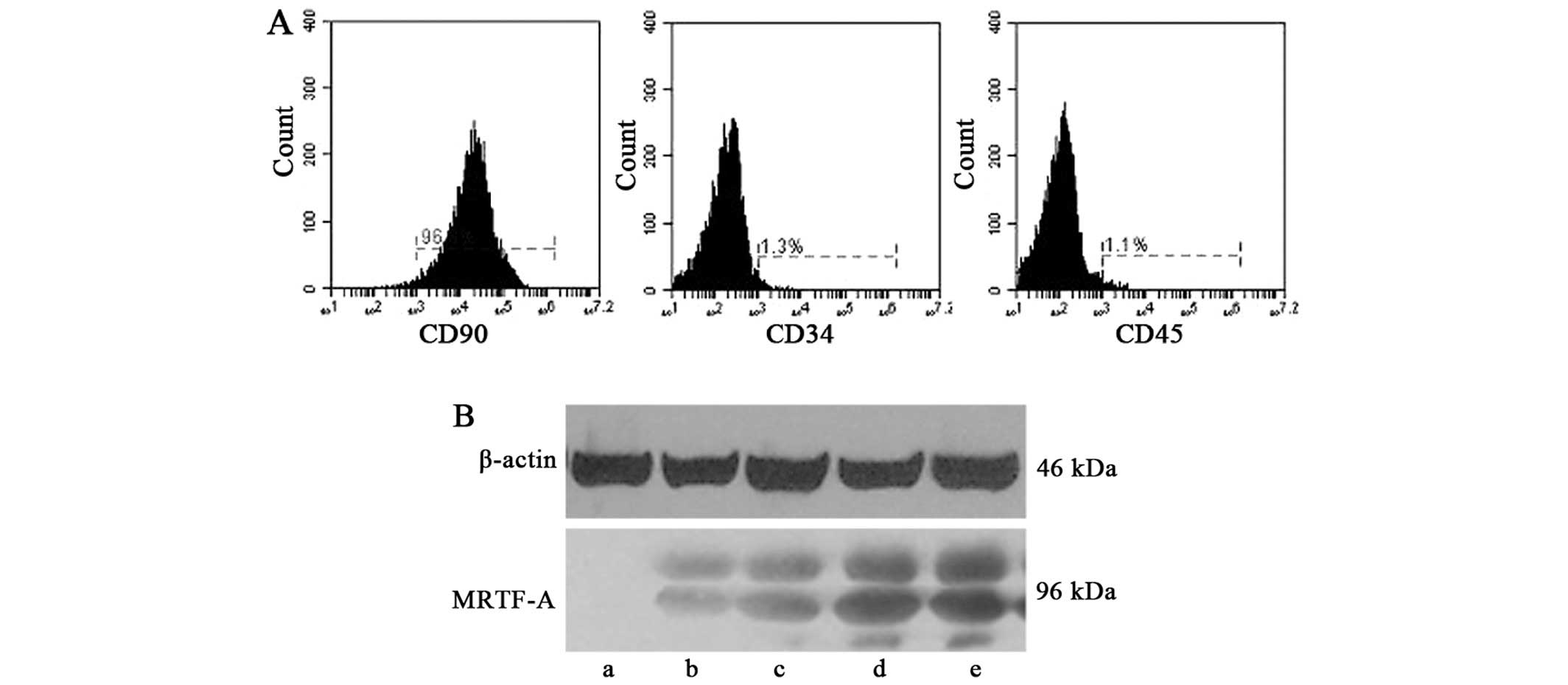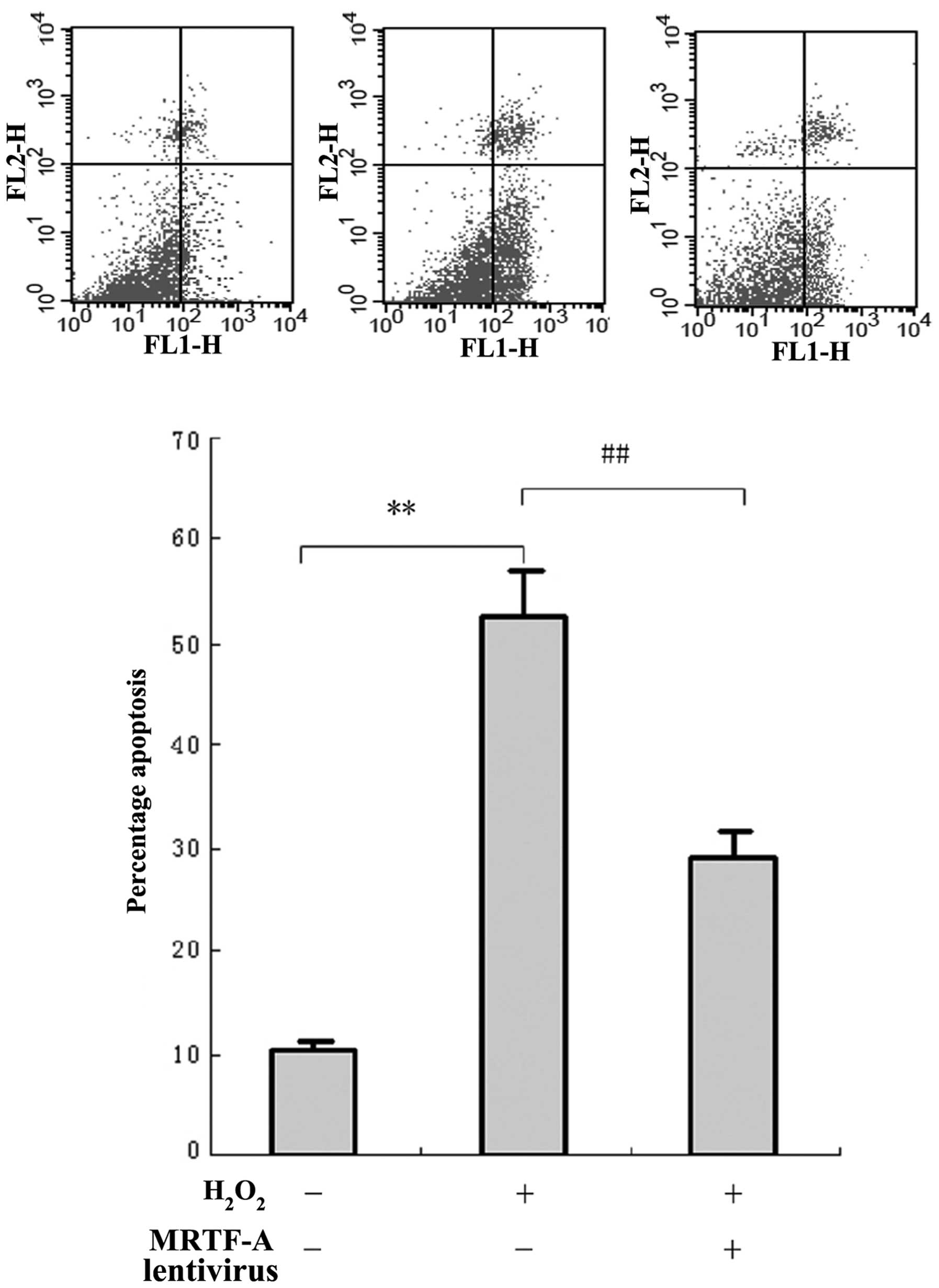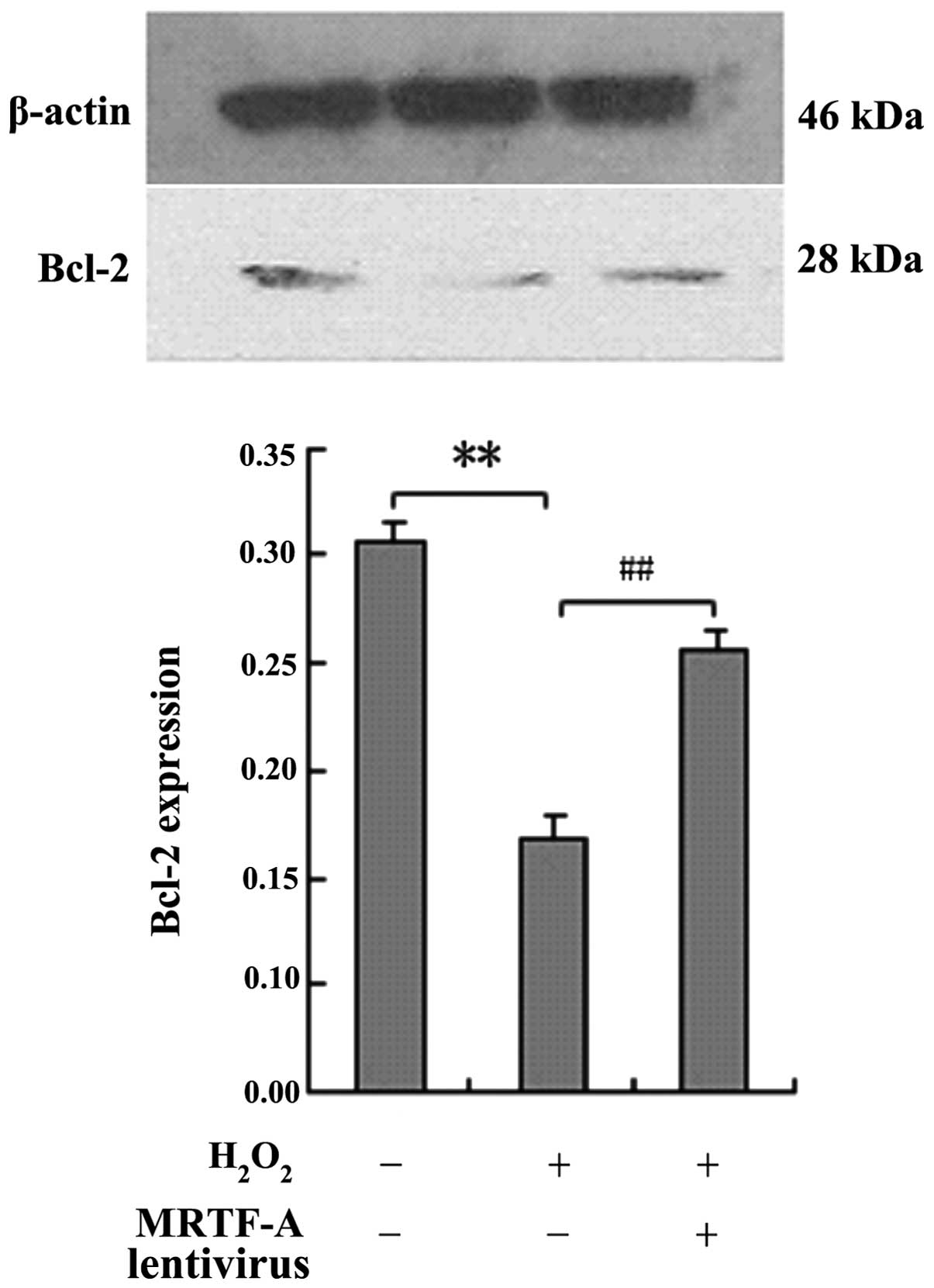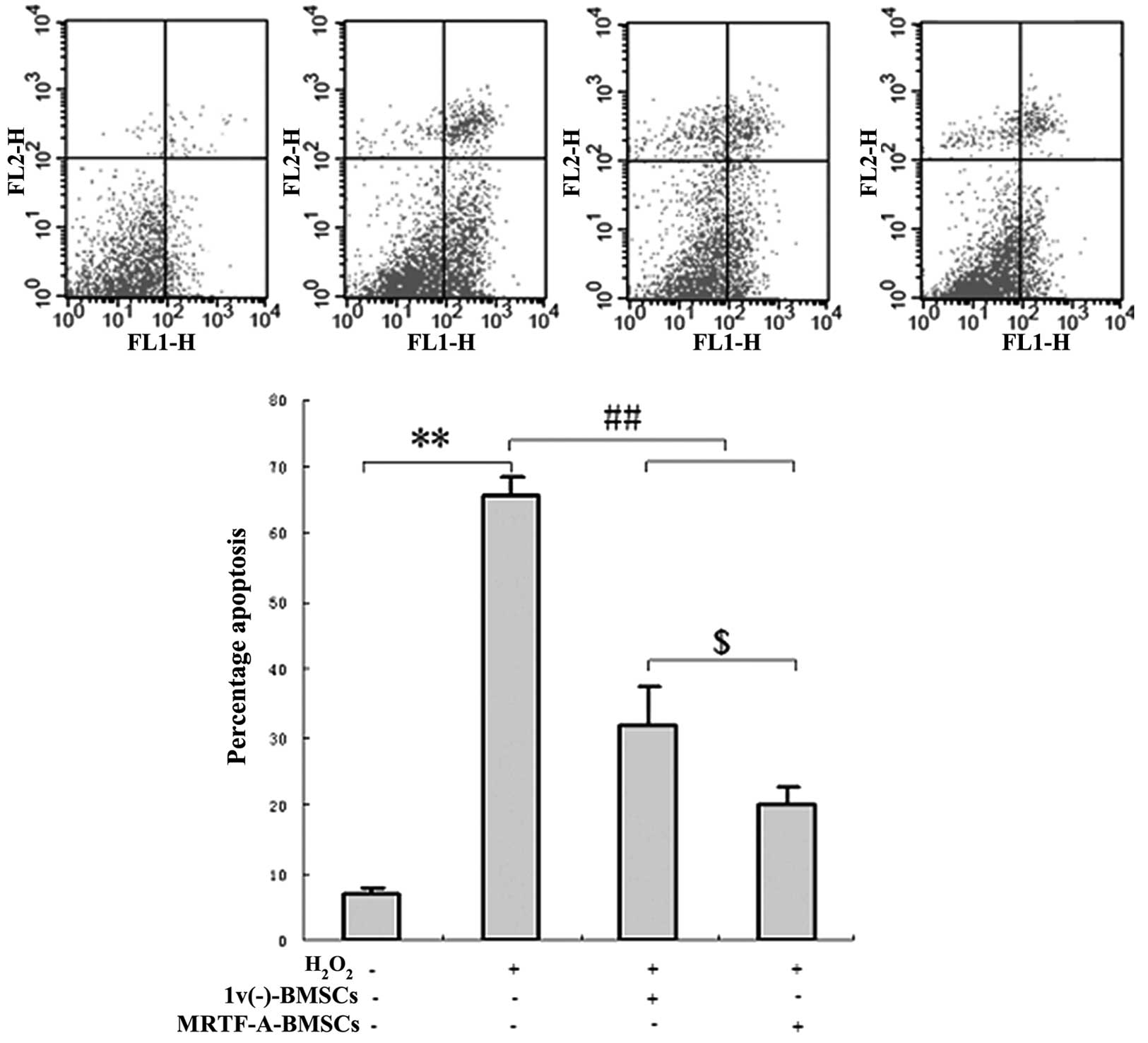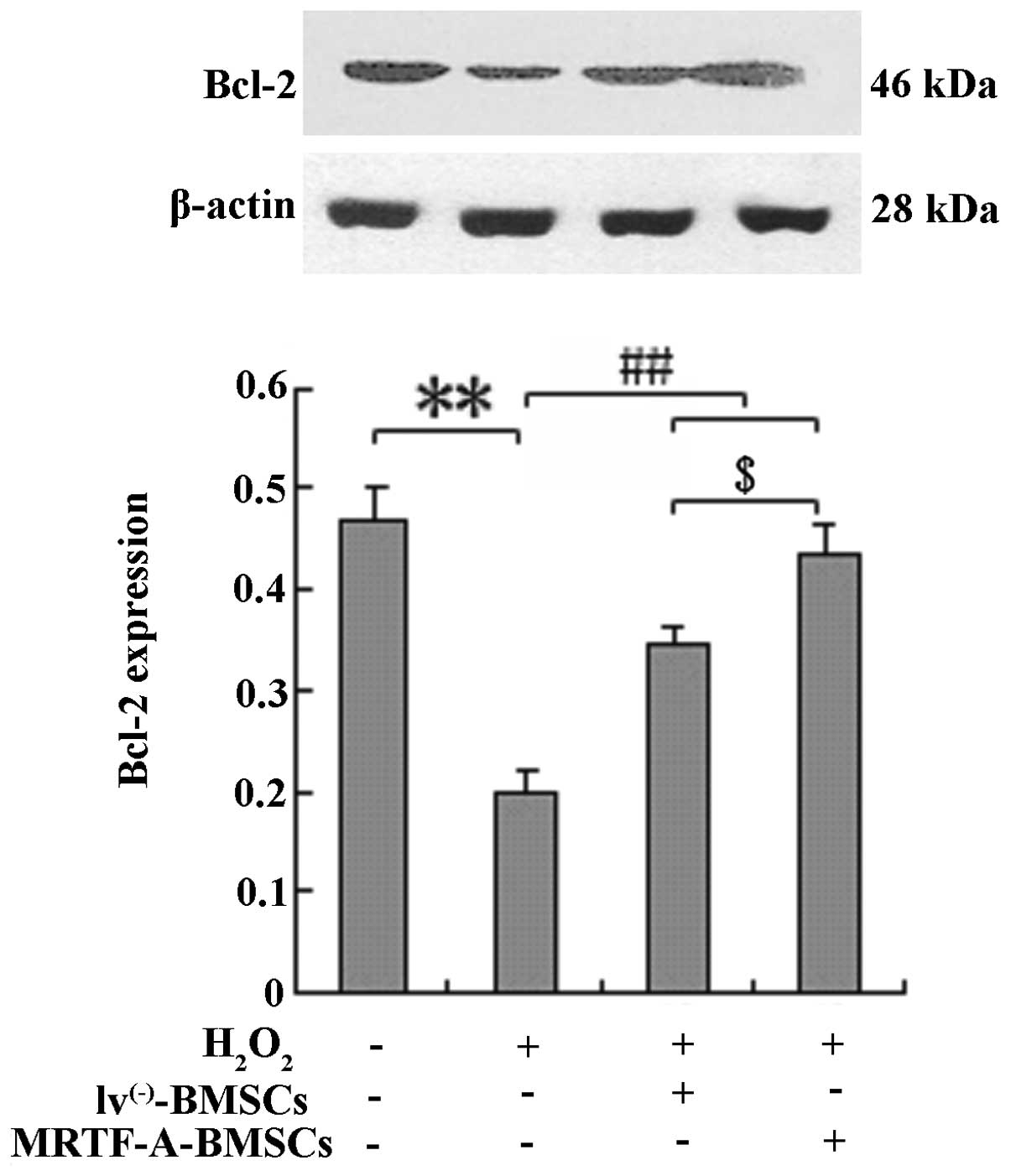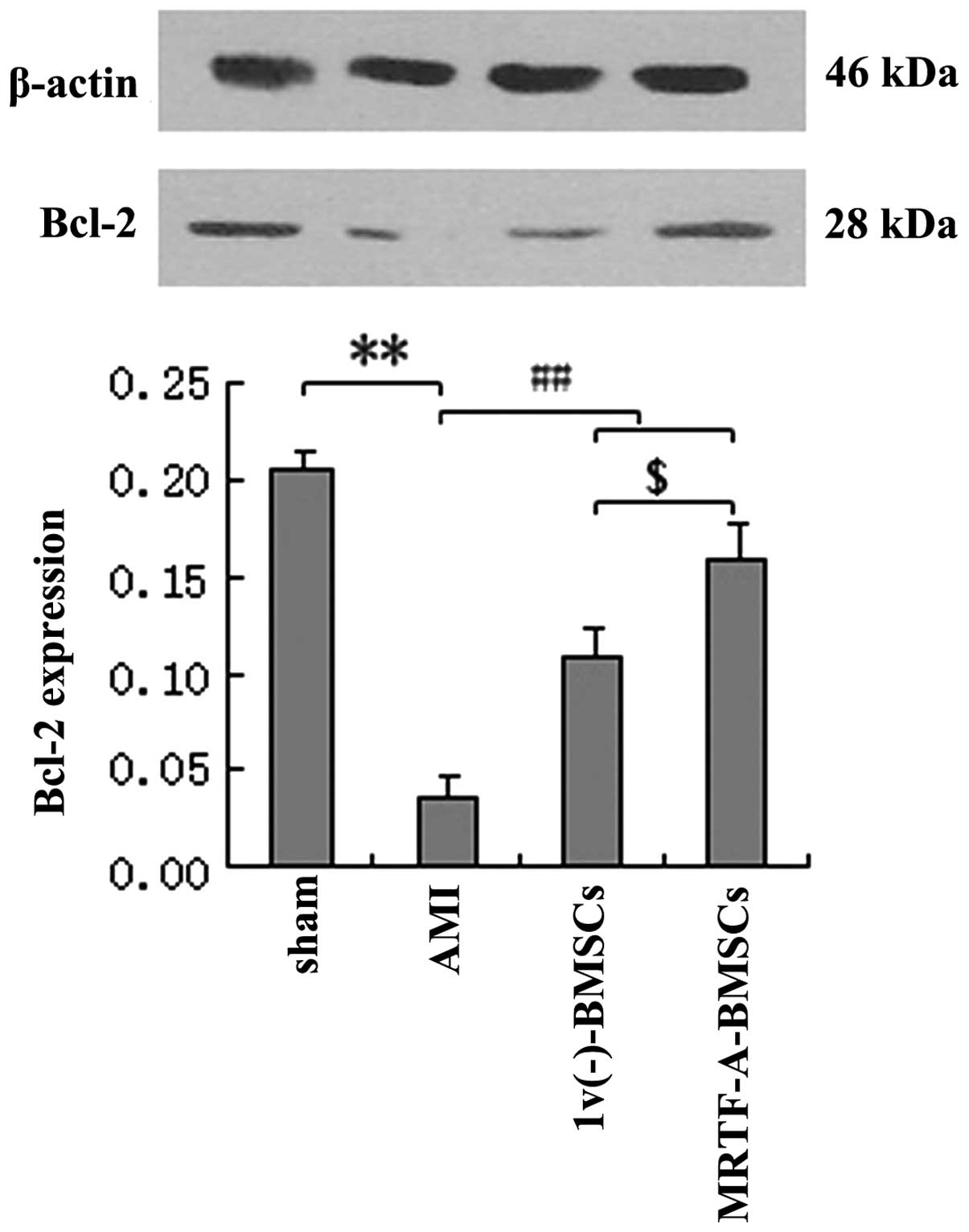Myocardin-related transcription factor-A-overexpressing bone marrow stem cells protect cardiomyocytes and alleviate cardiac damage in a rat model of acute myocardial infarction
- Authors:
- Published online on: June 25, 2015 https://doi.org/10.3892/ijmm.2015.2261
- Pages: 753-759
Abstract
Introduction
Cardiovascular disease (CVD) is the leading cause of mortality globally, with the majority of patients succumbing to ischemic heart disease. Acute myocardial infarction (AMI) is associated with the risk of cardiac failure and mortality (1–3). The mainstay of current therapies for AMI is re-perfusion of the infarcted area via thrombolysis, angioplasty or bypass-grafting. However, re-perfusion following ischemia/hypoxia induces further cardiomyocyte death (4). Over the past decade, bone marrow stem cell (BMSC) therapy has been shown to be safe in experimental animal models and AMI patients, and it is widely accepted that BMSCs improve cardiac function (5,6). BMSCs have the capacity to multiply and differentiate into new blood-vessel cells or to enhance mobilization of resident cardiac stem cells, predominantly via a paracrine mechanism (7,8). However, the efficacy of this approach is not sufficient to achieve cardiac repair.
Several pre-clinical studies have suggested that genetic strategies can improve BMSC survival and differentiation (9,10). Further studies have indicated that transplantation of gene-modified stem cells may be beneficial in mediating substantial functional recovery after AMI (11,12). However, achieving a high rate of cell survival after transplantation into an infarcted heart remains a challenge. Thus, it is necessary to reinforce BMSCs against the damaging environment, including high levels of pro-apoptotic factors, incurred as a result of ischemia and to improve the efficacy of BMSC therapy.
Serum response factors (SRF) play an important role in the regulation of nearly every known smooth muscle-specific gene via binding to the sequence [CC(A/T)6GG], termed a serum response element (SRE) (13,14). Studies have indicated that myocardin-related transcription factor-A (MRTF-A) is abundant in tissues from newborn and adult rats, elevates SRF-driven transcription and enhances the expression of target genes (13,15) that can contribute to cardiac and neuronal protection under various forms of stress (16,17).
The protective effects of MRTF-A against heart disease have been demonstrated in previous studies (18–20). Certain studies have indicated that MRTF-A regulates myofibroblast activation and fibrosis in response to the renin-angiotensin system and post-MI remodeling (20). Of note, normalization of activated myocardin signaling in the ventricular myocardium during the mid-stages of the development of heart failure can improve impaired ventricular function (21). Thus, MRTF-A is likely to be a key regulator of cardiac function.
In the present study, adult rat BMSCs were genetically modified to overexpress MRTF-A with the aim of protecting cardiomyocytes against hydrogen peroxide-induced damage and enhancing their resistance to ischemic conditions following transplantation in a rat model of AMI. It was hypothesized that genetic modification of BMSCs with regard to MRTF-A protects BMSCs against the ischemic environment and improves their viability in the early post-transplantation period, thereby enhancing cardiac functional recovery after AMI.
Materials and methods
Animals
Male Sprague-Dawley rats (aged 8–12 weeks, 250–280 g, n=48) were obtained from the Experimental Animal Center of Zhejiang Province (Zhejiang, China). Rats were housed at a constant room temperature of 22°C under a 12-h light/dark cycle with free access to food and drinking water. Housing facilities and all experimental protocols were performed according to the National Institutes of Health (NIH) Guide for the Care and Use of Laboratory Animals (NIH Publication no. 85-23, revised 1996), and approved by the Animal Care and Use Committee of Zhejiang University School of Medicine, which adopts the abovementioned NIH guidelines.
Sprague-Dawley rats were divided into four groups (six rats in each group): Sham group (sham), left thoracotomy without coronary artery ligation; AMI model group (AMI), acute myocardial infarction model; BMSCs treatment group [lv(−)-BMSCs], AMI model rats treated with empty vector; MRTF-A-modified BMSCs treatment group (MRTF-A-BMSCs), AMI model rats treated with MRTF-A-modified BMSCs.
AMI model and BMSC transplantation
Animals were anesthetized with pentobarbital (50 mg/kg body weight; Roche, Basel, Switzerland). All rats underwent thoracotomy at the fifth left intercostal space, the pericardium was opened and a loose 00 braided silk suture was placed around the left anterior descending coronary artery ~1–2 mm below its origin. To facilitate the successive removal of the suture, a small silicon ring was inserted in the silk thread below the knot. The chest was then closed with a silk suture to minimize heart displacement, taking care to leave the ends of the coronary suture threads emerging from the surgical wound (11,22). Immediately after ligation, a 31-gauge needle was used to inject 6×106 MRTF-A-BMSCs [injected at six sites (23)] into the anterior and lateral aspects of the viable myocardium bordering the infarction. Twelve AMI model rats were administered an equal volume of Dulbecco's modified Eagle's medium (DMEM; Sigma-Aldrich, St. Louis, MO, USA) via the same route served as medium controls. Twelve rats were injected with the empty vector-transfected BMSCs. Animals were sacrificed at 1 week post-transplantation.
Primary cardiomyocyte culture
The primary cardiomyocytes were prepared from newborn Sprague-Dawley rats as previously described (24). Briefly, post-natal day-0 primary cardiomyocytes were dissociated with 0.25% pancreatic enzymes (Sigma-Aldrich) and cultured at a density of 2×106/plate in 35-mm plates. The primary cardiomyocytes were cultured in 90% DMEM, 10% fetal bovine serum (FBS; Gibco-Invitrogen, Carlsbad, CA, USA) and 100 U/ml penicillin/0.1 mg/ml streptomycin (Sigma-Aldrich).
Isolation, culture and expansion of BMSCs
BMSCs were prepared according to previous methods (25,26). Male Sprague-Dawley rats were sacrificed by cervical dislocation, femurs and tibias were removed and carefully flushed with DMEM-low glucose (DMEM-LG; HyClone Laboratories, Inc., Logan, UT, USA) using a 0.45-mm syringe needle until the bones became pale. The released cells were discarded and the bones were dissected into fragments of 1–3 mm3 and digested with collagenase II (0.5 mg/ml; Sigma-Alrich) for 1–2 h in a shaking incubator at 37°C and a shaking speed of 200 rpm. The collagenase was de-activated by dilution with DMEM-LG containing 10% FBS. The digested bone fragments were also washed by centrifuging twice for 5 min at 100 × g followed by culture in a 60-mm dish (Costar, Corning Inc., Corning, NY, USA) with DMEM-LG containing 10% FBS and penicillin/streptomycin at 37°C in a 5% CO2 humidified incubator. To isolate putative BMSCs, after 72 h of culture, non-adherent cells and tissue debris were removed with phosphate-buffered saline (PBS; HyClone Laboratories), and adherent cells were maintained. On reaching 70–80% confluence, these adherent cells were detached from the plate by digestion with 0.25% (wt/v) trypsin/0.02% (wt/v) EDTA (Gibco-BRL, Invitrogen Life Technologies, Carlsbad, CA, USA) for 2–3 min and the cells were re-plated. The medium was replaced every 2–3 days.
Identification of BMSCs by flow cytometric analysis
At passage three, the cultured BMSCs were detached from the plates by trypsin-EDTA digestion. Aliquots of cells (1×106) were washed with cold PBS and re-suspended in 100 µl PBS per Eppendorf tube and stained with fluorescein isothiocyanate-conjugated anti-mouse CD45 (Becton-Dickinson, San Jose, CA, USA), phycoerythrin (PE)-conjugated anti-mouse CD34 (eBioScience, San Diego, CA, USA) and CD90 (eBioScience) antibodies at a concentration of 2 µg/ml at 4°C for 30 min. One tube of unstained cells was prepared as a control for the staining antibodies. Data were acquired using a BD FACScalibur fluorescence activated cell sorting cytometer (BD Biosciences, San Jose, CA, USA) and analyzed using CellQuest software (BD Accuri C6 Software 1.0.264.21; BD Biosciences).
Transfection of BMSCs with lentiviral vector
The lentiviral vector encoding MRTF-A was obtained from ShengGong (ShenGong, Shanghai, China). Briefly, BMSCs (4×105 cells/well) at passage three were plated in a six-well plate (Costar) 24 h prior to transfection. BMSCs were incubated with 5 µl recombinant lentivirus (1×108 particles/ml) for at least 24 h in minimal culture medium containing polybrene (final concentration, 8 mg/l; Sigma-Aldrich). At 24, 48, 72 and 96 h after the first infection, lentiviral transduction of BMSCs was assessed by western blot analysis. Unbound virus was removed and replaced with fresh complete medium. The cells were then incubated for a further five days prior to H2O2 treatment. BMSCs were infected with 5 µl of the empty lentiviral vector (1×108 particles/ml) as a control. The multiplicity of infection was 10.
Hydrogen peroxide treatment and cell viability assay
BMSCs (1.2×106) were treated with H2O2 (200 µM at 37°C for 3 h; Beyotime Institute of Biotechnology, Haimen, China) after recombinant lentiviral infection. In addition to this, the cardiomyocytes were treated with BMSCs for 2 h (BMSCs vs. cardiomyocytes is 1:1) and 50 µM H2O2 were then added to the cell mixture. BMSC and cardiomyocyte apoptosis was assayed by Annexin V-PE/7-actinomycin D (7ADD) staining (BD-559763; BD Biosciences) and analyzed by flow cytometry.
Histopathology
Ηematoxylin and eosin (H&E) staining was adopted to examine the histological alterations in the heart tissue. Briefly, the heart tissues preserved in 4% paraformaldehyde were dehydrated using Carnoy's fluid and then used to prepare paraffin-embedded sections. After being stained with H&E (Beyotime Institute of Biotechnology), the heart histomorphology of the tree shrews was observed and photographed using an Olympus imaging system (CX31; Olympus Optical Co., Ltd, Tokyo, Japan).
Western blot analysis
Cell pellets were lysed in 0.1 ml of RIPA buffer. Total cellular proteins were extracted using a Total Protein Extraction kit (Beyotime Institute of Biotechnology), quantified usi ng the Bicinchoninic Acid Protein assay kit (Beyotime Institute of Biotechnology), separated by 10% SDS-PAGE (Beyotime Institute of Biotechnology) and transferred onto nitrocellulose membranes (Millipore, Billerica, MA, USA) at 200 mA. The membranes were blocked with 5% skimmed milk, incubated with anti-B-cell lymphoma 2 (Bcl-2) (monoclonal; 1:2,000 dilution; cat no. sc-7382; Santa Cruz Biotechnology, Dallas, TX, USA), anti-MRTF-A (monoclonal; 1:5,000 dilution; cat no. sc-398675; Santa Cruz Biotechnology) and anti-β-actin (monoclonal; 1:5,000 dilution; cat no. sc-8432; Santa Cruz Biotechnology) antibodies, and, after washing with 0.1% Tween-20 in TBS, were incubated with horseradish-peroxidase-conjugated secondary antibodies for 1.5 h at room temperature (1:10,000; Beyotime Institute of Biotechnology). The bands were then evaluated by densitometric analysis using a Desaga Cab UVIS scanner and Desaga ProViDoc software (Desaga GmbH, Wiesloch, Germany). Enhanced chemiluminescence detection of the target protein was performed with a computerized image processing system (ImageQuant 1.19; Molecular Dynamics, Sunnyvale, CA, USA) and exposed using an X-ray film.
Statistical analyses
All values are expressed as the means ± standard deviation and analyzed by SPSS Statistical software (SPSS Statistics 22.0; SPSS Inc., Stanford, CA, USA). One-way analysis of variance with Scheffe's post-hoc test for unequal sample sizes was used to compare numeric data among the four experimental groups. Datasets consisting of two groups only were compared using the unpaired Student's t-tests. A level of P<0.05 was considered to indicate statistical significance.
Results
Identification of BMSCs and infection with lentivirus
The adherent BMSCs at passage three exhibited a surface antigen phenotype consistent with those previously reported (27); CD90-positive and CD34- and CD45-negative. Flow cytometric analysis was employed to determine surface marker expression (Fig. 1A). The cultured BMSCs were devoid of t he BMSC-specific markers CD34 and CD45, while high expression of CD90 was observed.
BMSCs at passage three were infected with 5 µl recombinant lentivirus (1×108 particles/ml). At 24, 48, 72 and 96 h after the first infection, lentiviral transduction of BMSCs was confirmed by western blot analysis (Fig. 1B). A similar protocol was used for preparing negative control BMSCs transfected with empty vector. Successfully transfected BMSCs were used for transplantation into the rat model of AMI.
MRTF-A overexpression enhances BMSC survival
To investigate the resistance of MRTF-A to cellular injury, BMSCs were exposed to H2O2 and cell viability was evaluated by flow cytometric analysis of Annexin V-PE/7ADD staining (Fig. 2A). BMSCs displayed morphological changes typical of apoptosis and necrosis after H2O2-mediated cellular injury. However, the number of apoptotic and necrotic cells in the MRTF-A group (27.9±5.2%) was significantly lower compared with that in the control (52.6±6.9%; P<0.01). This indicated that MRTF-A overexpression in the lentivirus-infected BMSCs partially prevented the apoptosis induced by cellular injury.
BMSCs were exposed to H2O2 and Bcl-2 protein expression was analyzed by western blot analysis to elucidate whether the protective effects of MRTF-A are mediated by upregulated expression of the apoptosis-associated protein Bcl-2 (Fig. 3). Compared with the control cells, MRTF-A-overexpressing BMSCs displayed enhanced Bcl-2 expression following treatment with H2O2 (P<0.01).
MRTF-A-overexpressing BMSCs exert increased protective effects on cardiomyocyte viability in an ex vivo model of cellular injury
To determine the protective effects of MRTF-A-modified BMSCs on cardiomyocyte viability in an ex vivo model of cellular injury, primary cardiomyocytes were co-cultured with lv(−)-BMSCs or with MRTF-A-BMSCs in six-well plates. After five days, the cardiomyocytes were exposed to hydrogen peroxide and analyzed by flow cytometry. After exposure to hydrogen peroxide, the proportion of apoptotic cells was significantly reduced in the primary cardiomyocytes co-cultured with lv(−)-BMSCs (32.75±6.21%) or MRTF-A-BMSCs (21.51±5.44%) compared with that of the primary cardiomyocytes cultured in isolation (66.83±7.58; P<0.05) (Fig. 4).
Consistent with these results, after hydrogen peroxide exposure, the expression of the apoptosis-associated protein Bcl-2 was significantly increased in the primary cardiomyocytes co-cultured with lv(−)-BMSCs or MRTF-A-BMSCs compared with that detected in the primary cardiomyocytes cultured in isolation (P<0.01; Fig. 5). Furthermore, the protein expression of Bcl-2 in the primary cardiomyocytes co-cultured with MRTF-A-BMSCs following hydrogen peroxide exposure was obviously increased compared with that in cardiomyocytes co-cultured with lv(−)-BMSCs (Fig. 5).
MRTF-A-overexpressing BMSCs prevent cardiac damage after AMI
The effect of MRTF-A overexpression on the efficacy of bone marrow stem cell-based therapy was evaluated in a rat model of AMI. Immediately after ligation of the coronary artery, 6×106 MRTF-A-BMSCs were injected into the infarction area. Animals were sacrificed at 1 week after cell transplantation and the extent of myocardial injury was evaluated in H&E-stained sections of myocardial tissue (Fig. 6). While no cardiac damage was apparent in the sections from the sham group, extensive damage was detected in those from the AMI group. The damaged myocardial tissue displayed marked cardiomyocyte necrosis and a number of red cells. The damage to cardiomyocytes induced by AMI was effectively improved after transplantation of lv(−)-BMSCs or MRTF-A-BMSCs, with obviously reduced necrosis and numbers of red cells observed in the myocardial tissue sections, compared to those from the AMI group. Of note, fewer red blood cells were observed in the MRTF-A-BMSCs group compared with those in the lv(−)-BMSCs group.
In addition, the expression levels of Bcl-2 protein in myocardial tissues after AMI following transplantation of lv(−)-BMSCs or MRTF-A-BMSCs were assessed. Bcl-2 expression in the AMI group was significantly decreased compared with that in the sham group (P<0.01), while the levels of Bcl-2 protein in the lv(−)-BMSC and MRTF-A-BMSC groups were significantly increased compared with those in the AMI group (P<0.01) (Fig. 7). In addition, the expression of Bcl-2 after MRTF-A-BMSC transplantation was significantly greater than that after lv(−)-BMSC transplantation.
Discussion
Although it is promising to use BMSCs in cell-based therapy (CBT) for AMI, BMSC survival is poor following transplantation into the heart following AMI. This may limit the functional improvements associated with this approach (28) and therefore, strategies to enhance BMSC survival are critically required for the clinical translation of this CBT.
MRTF-A, as a co-factor of SRF that is required for gene expression, has been implicated in myocardial survival (20). The present study investigated the ability of BMSC transplantation alone and in combination with and MRTF-A overexpression to suppress cardiomyocyte injury induced by hypoxia-ischemia.
Initially, the BMSCs were isolated from male Sprague-Dawley rats and were subsequently cultured and expanded. Immunophenotyping analysis of BMSC surface markers revealed that these cells exhibited a surface antigen phenotype consistent with those reported previously (CD90-positive; CD34-and CD45-negative) (27). One of the significant challenges in the clinical application of BMSC-based therapy is the low survival of transplanted cells in vivo, particularly in the heart following AMI (29). The results of the present study showed that overexpression of MRTF-A in BMSCs partially prevented hydrogen peroxide-induced apoptosis in primary cardiomyocytes ex vivo and enhanced Bcl-2 expression in BMSCs, suggesting that MRTF-A may enhance the survival of BMSCs.
The modulation of apoptosis-associated gene expression by MRTF-A may be involved in the enhanced survival and protective effects of MRTF-A-BMSCs on cardiomyocytes. Upregulation of Bcl-2 had an important role in mediating the beneficial effects of CBT with MRTF-A-BMSCs. Western blot analysis showed that Bcl-2 was upregulated in MRTF-A- modified BMSCs. Furthermore, H2O2-induced apoptosis was ameliorated in primary cardiomyocytes co-cultured with MRTF-A-modified BMSCs, indicating that the apoptosis-associated pathways were partially inhibited by the reduction of Bcl-2 expression.
Further experiments showed that transplantation of MRTF-A-BMSCs markedly improved these parameters, indicating that MRTF-A enhances the efficacy of CBT with BMSCs. Lentivirus-mediated transduction and stable expression of MRTF-A in BMSCs improved the efficiency of CBT, demonstrating that the effect of MRTF-A is independent of lentiviral transduction. Thus, the results of the present study suggested that ex vivo modification of BMSCs with signaling molecules, such as MRTF-A, can improve their therapeutic potential in CBT.
In the present study, the effect of MRTF-A regarding the extension of the survival of grafted BMSCs under ischemia was identified in vitro and in vivo. It was confirmed that overexpression of MRTF-A reduced BMSC death and apoptosis induced by hydrogen peroxide exposure. Furthermore, in vivo transplantation of MRTF-A-BMSCs enhanced the survival of myocardial tissue in a rat model of AMI. These observations suggested that overexpression of MRTF-A in BMSCs may be of significant value in improving the efficacy of stem cell therapy following a broad range of cardiac diseases.
Acknowledgments
The present study was supported by the Medical Science and Technology Plan Projects of Zhejiang Province (no. 2012KYA149), and the Major Social Development Project of the Science and Technology Agency of Zhejiang Province (no. 2012C03SA1E0003).
References
|
Sabbah HN and Sharov VG: Apoptosis in heart failure. Prog Cardiovasc Dis. 40:549–562. 1998. View Article : Google Scholar : PubMed/NCBI | |
|
Mill JG, Stefanon I, dos Santos L and Baldo MP: Remodeling in the ischemic heart: the stepwise progression for heart failure. Braz J Med Biol Res. 44:890–898. 2011. View Article : Google Scholar : PubMed/NCBI | |
|
Takemura G and Fujiwara H: Role of apoptosis in remodeling after myocardial infarction. Pharmacol Ther. 104:1–16. 2004. View Article : Google Scholar : PubMed/NCBI | |
|
Hausenloy DJ and Yellon DM: Myocardial ischemia-reperfusion injury: A neglected therapeutic target. J Clin Invest. 123:92–100. 2013. View Article : Google Scholar : PubMed/NCBI | |
|
Jeong H, Yim HW, Cho Y, Park HJ, Jeong S, Kim HB, Hong W and Kim H: The effect of rigorous study design in the research of autologous bone marrow-derived mononuclear cell transfer in patients with acute myocardial infarction. Stem Cell Res Ther. 4:822013. View Article : Google Scholar : PubMed/NCBI | |
|
Fisher SA, Dorée C, Brunskill SJ, Mathur A and Martin-Rendon E: Bone marrow stem cell treatment for ischemic heart disease in patients with no option of revascularization: A systematic review and meta-analysis. PLoS One. 8:e646692013. View Article : Google Scholar : PubMed/NCBI | |
|
Gnecchi M, He H, Liang OD, et al: Paracrine action accounts for marked protection of ischemic heart by Akt-modified mesenchymal stem cells. Nat Med. 11:367–368. 2005. View Article : Google Scholar : PubMed/NCBI | |
|
Behfar A, Zingman LV, Hodgson DM, Rauzier J-M, Kane GC, Terzic A and Pucéat M: Stem cell differentiation requires a paracrine pathway in the heart. FASEB J. 16:1558–1566. 2002. View Article : Google Scholar : PubMed/NCBI | |
|
Williams AR, Suncion VY, McCall F, Guerra D, Mather J, Zambrano JP, Heldman AW and Hare JM: Durable scar size reduction due to allogeneic mesenchymal stem cell therapy regulates whole-chamber remodeling. J Am Heart Assoc. 2:e0001402013. View Article : Google Scholar : PubMed/NCBI | |
|
Forest VF, Tirouvanziam AM, Perigaud C, Fernandes S, Fusellier MS, Desfontis JC, Toquet CS, Heymann MF, Crochet DP and Lemarchand PF: Cell distribution after intracoronary bone marrow stem cell delivery in damaged and undamaged myocardium: Implications for clinical trials. Stem Cell Res Ther. 1:42010. View Article : Google Scholar : PubMed/NCBI | |
|
Li W, Ma N, Ong LL, et al: Bcl-2 engineered MSCs inhibited apoptosis and improved heart function. Stem Cells. 25:2118–2127. 2007. View Article : Google Scholar : PubMed/NCBI | |
|
Das H, George JC, Joseph M, et al: Stem cell therapy with overexpressed VEGF and PDGF genes improves cardiac function in a rat infarct model. PLoS One. 4:e73252009. View Article : Google Scholar : PubMed/NCBI | |
|
Pipes GC, Creemers EE and Olson EN: The myocardin family of transcriptional coactivators: Versatile regulators of cell growth, migration, and myogenesis. Genes Dev. 20:1545–1556. 2006. View Article : Google Scholar : PubMed/NCBI | |
|
Miano JM: Serum response factor: toggling between disparate programs of gene expression. J Mol Cell Cardiol. 35:577–593. 2003. View Article : Google Scholar : PubMed/NCBI | |
|
Wang D, Chang PS, Wang Z, Sutherland L, Richardson JA, Small E, Krieg PA and Olson EN: Activation of cardiac gene expression by myocardin, a transcriptional cofactor for serum response factor. Cell. 105:851–862. 2001. View Article : Google Scholar : PubMed/NCBI | |
|
Mikhailov AT and Torrado M: In search of novel targets for heart disease: Myocardin and myocardin-related transcriptional cofactors. Biochem Res Int. 2012:9737232012. View Article : Google Scholar : PubMed/NCBI | |
|
Cao XL, Hu XM, Hu JQ and Zheng WX: Myocardin-related transcription factor-A promoting neuronal survival against apoptosis induced by hypoxia/ischemia. Brain Res. 1385:263–274. 2011. View Article : Google Scholar : PubMed/NCBI | |
|
Latif N, Sarathchandra P, Chester AH and Yacoub MH: Expression of smooth muscle cell markers and co-activators in calcified aortic valves. Eur Heart J. 36:1335–1345. 2015. View Article : Google Scholar | |
|
Liao XH, Wang N, Liu QX, Qin T, Cao B, Cao DS and Zhang TC: Myocardin-related transcription factor-A induces cardiomyocyte hypertrophy. IUBMB Life. 63:54–61. 2011. View Article : Google Scholar : PubMed/NCBI | |
|
Small EM, Thatcher JE, Sutherland LB, Kinoshita H, Gerard RD, Richardson JA, Dimaio JM, Sadek H, Kuwahara K and Olson EN: Myocardin-related transcription factor-a controls myofibroblast activation and fibrosis in response to myocardial infarction. Circ Res. 107:294–304. 2010. View Article : Google Scholar : PubMed/NCBI | |
|
Parmacek MS: Myocardin-related transcription factor-A: mending a broken heart. Circ Res. 107:168–170. 2010. View Article : Google Scholar : PubMed/NCBI | |
|
Guo J, Li HZ, Wang LC, Zhang WH, Li GW, Xing WJ, Wang R and Xu CQ: Increased expression of calcium-sensing receptors in atherosclerosis confers hypersensitivity to acute myocardial infarction in rats. Mol Cell Biochem. 366:345–354. 2012. View Article : Google Scholar : PubMed/NCBI | |
|
Zhao SL, Zhang YJ, Li MH, Zhang XL and Chen SL: Mesenchymal stem cells with overexpression of midkine enhance cell survival and attenuate cardiac dysfunction in a rat model of myocardial infarction. Stem Cell Res Ther. 5:372014. View Article : Google Scholar : PubMed/NCBI | |
|
Sacherer M, Sedej S, Wakuła P, et al: CONTICA investigators: JTV519 (K201) reduces sarcoplasmic reticulum Ca2+ leak and improves diastolic function in vitro in murine and human non-failing myocardium. Br J Pharmacol. 167:493–504. 2012. View Article : Google Scholar : PubMed/NCBI | |
|
Cai BZ, Meng FY, Zhu SL, et al: Arsenic trioxide induces the apoptosis in bone marrow mesenchymal stem cells by intracellular calcium signal and caspase-3 pathways. Toxicol Lett. 193:173–178. 2010. View Article : Google Scholar : PubMed/NCBI | |
|
Gao YS, Ding H, Xie XT and Zhang CQ: Osteogenic induction protects rat bone marrowederived mesenchymal stem cells against hypoxia-induced apoptosis in vitro. J Surg Res. 184:873–879. 2013. View Article : Google Scholar : PubMed/NCBI | |
|
Ning J, Li C, Li H and Chang J: Bone marrow mesenchymal stem cells differentiate into urothelial cells and the implications for reconstructing urinary bladder mucosa. Cytotechnology. 63:531–539. 2011. View Article : Google Scholar : PubMed/NCBI | |
|
Gnecchi M, Danieli P and Cervio E: Mesenchymal stem cell therapy for heart disease. Vascul Pharmacol. 57:48–55. 2012. View Article : Google Scholar : PubMed/NCBI | |
|
Clifford D, Fisher S, Brunskill S, Doree C, Mathur A, Watt S and Martin-Rendon E: Stem cell treatment for acute myocardial infarction. Cochrane Database Syst Rev. 2:CD0065362012.PubMed/NCBI |



